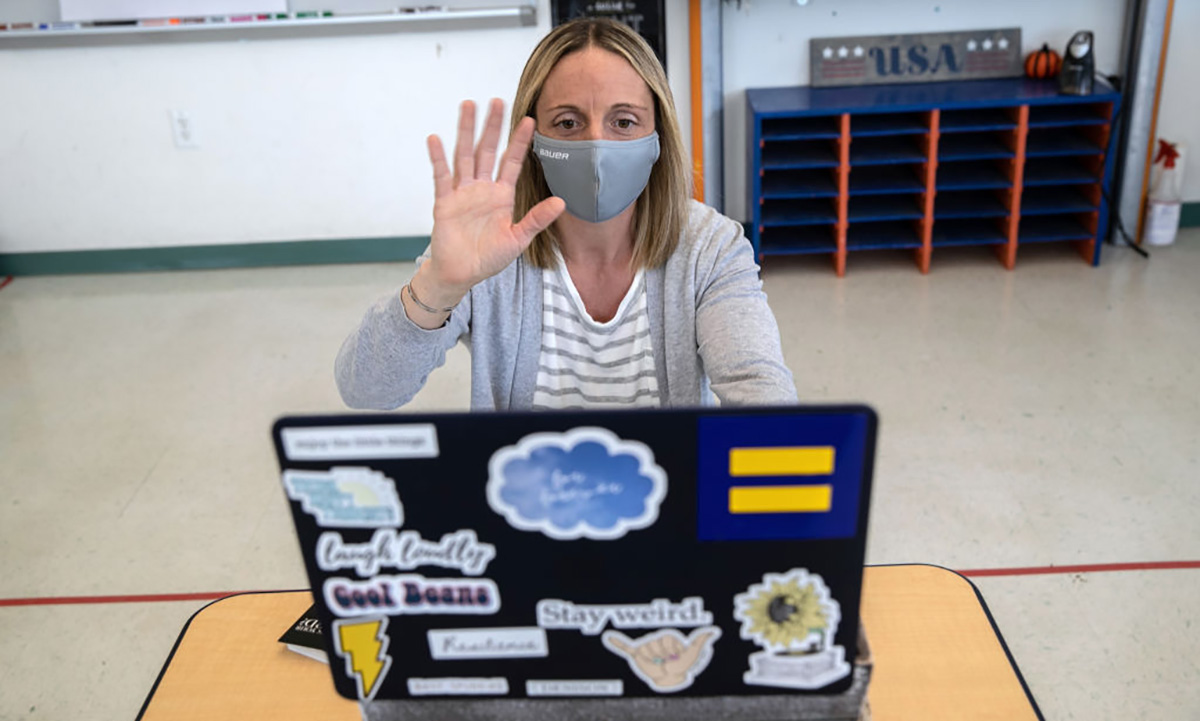Teachers Felt More COVID Anxiety than Healthcare Workers, Study Finds
Research shows that educators were more likely than other workers to report a range of mental health ailments during the worst months of the pandemic

Get stories like these delivered straight to your inbox. Sign up for The 74 Newsletter
Teachers were far more likely than other workers to experience anxiety during the first year of the pandemic, a newly released study has found. And among teachers, those who worked remotely for most of the 2020-21 school year reported higher rates of depression and loneliness than those who worked in-person.
The study, which leverages a massive survey sample collected online throughout the pandemic, was published Tuesday morning in Educational Researcher, a peer-reviewed journal of the American Educational Research Association. Its findings highlight the mental and emotional toll exacted by COVID, while also offering new insights into how different employment sectors coped with its hardships.
Polling has consistently shown teachers and other school employees reporting signs of elevated stress over the last two years, with education experts worrying that higher levels of burnout might cause more educators to leave the profession. Joseph Kush, a professor of psychology at James Madison University and one of the paper’s authors, said that he and his collaborators were “kind of shocked” at the results.
“Our thought was that healthcare workers battling this virus on the front lines would clearly have the highest levels of distress,” Kush said. “And they were very high, but we found that teachers were actually quite a bit higher.”
The study relies on data from the COVID-19 Trends and Impact Survey, an ongoing measure of public opinion developed by Facebook and Carnegie Mellon’s epidemiology-focused Delphi Research Group. The poll solicits daily responses from a random sample of Facebook users about their physical and mental health.
Kush and his co-authors, a trio of researchers from Johns Hopkins University, gathered data from between September 2020 and March 2021 — in many ways the nadir of COVID, when deaths often exceeded 3,000 per day and vaccines were still not widely administered. They focused on information from over 2.7 million employed adults, including nearly 135,000 teachers. Demographic identifiers related to age, gender, educational attainment, household size, and level of economic worry were also included.
Finally, they compared self-reported instances of anxiety, depression, and isolation among four different areas of the American workforce: education (from preschool through high school), healthcare workers, office workers, and a broad category of “other” occupations, including military personnel and agricultural workers.
The results were striking. By far, teachers had the highest odds of reporting anxiety — 40 percent higher than healthcare workers, 20 percent higher than office workers, and 30 percent higher than members of the “other” category.” They were also likelier than healthcare workers, though by smaller increments, to report feeling isolated or depressed; office workers and “others” were notably more likely than teachers to say they were feeling isolated.
The spectrum of mental health ailments interacts somewhat unexpectedly with the frequency of remote vs. in-person work. While the healthcare category is broad — encompassing nurses and doctors, but also dentists, home health aides, and therapists — it is taken to represent the group that incurred the greatest risk of contracting COVID. White-collar employees, by contrast, were perhaps the demographic most shielded from the pandemic’s effects, with a huge proportion of offices operating remotely through the early months of 2021.
In the middle sat teachers, who fluctuated between in-person and remote instruction depending on timing and geography. School employees often received little clear guidance from state or federal authorities on how best to mitigate health risks to themselves and their students, and most were also navigating a chaotic transition to virtual teaching.
Kush said that while the degree of remote work was perhaps the single factor most correlated with worsening mental health, the education profession sat particularly uneasily atop the pandemic’s ambiguities.
“Education was unique in that it grappled, even within districts, about whether teachers were going to work in-person from week to week,” said Kush. “That change, and the uncertainty in that, clearly brings this spike in anxiety.”
Notably, the remote-vs.-in-person dynamic was also present within the teaching workforce itself. Teachers conducting their lessons in Zoom classrooms were substantially more likely to experience symptoms of depression and (somewhat predictably) isolation than their colleagues working in school buildings.
Whether the study’s findings can be boiled down to a simple mechanism — that working away from customers, colleagues, and students simply led to lower emotional well-being — will depend on the findings of further research, including an investigation of which workers reported relatively worse mental health before COVID emerged and after its most severe disruptions were allayed.
One demographic caveat worthy of further examination pertains to gender: Female teachers were 70 percent more likely than male teachers to say that they felt anxiety during the period covered by the study. The teaching field is predominantly female, though the same could be said of healthcare workers.
“The makeup of the education and healthcare workforces is relatively similar, and we see gender differences both across all occupations and when we examine teachers exclusively,” Kush said. “So not only is this finding generalizable across all occupations, but even within teachers.”
Get stories like these delivered straight to your inbox. Sign up for The 74 Newsletter


